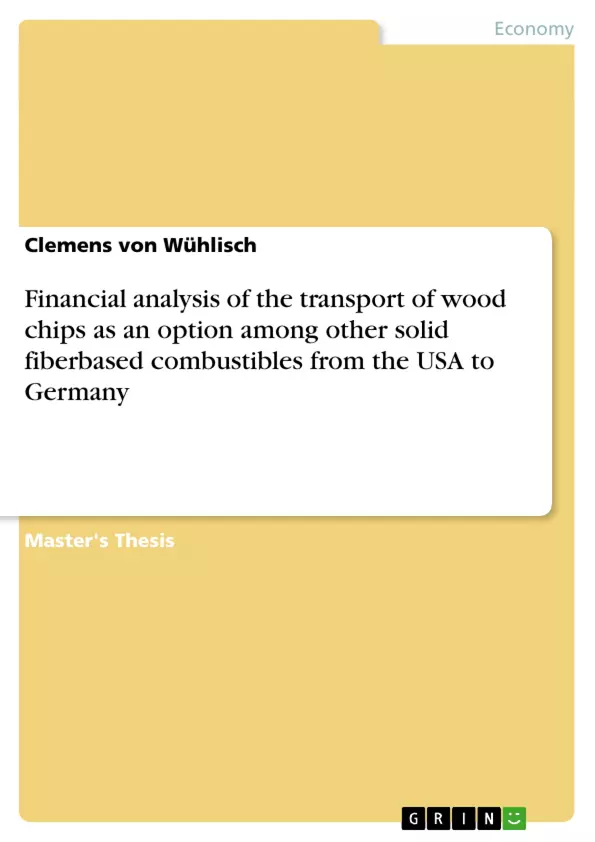The European demand for wood chips and wood pellets is strongly increasing in the course of a new energy policy. This new policy limits the use of non-renewable energy sources to a maximum of 80 % in favor of a 20 % renewable energy mix by 2020. Besides the main renewable energy sources, wind and hydro, woody biomass shall contribute the largest part of the generation of heat and power. As North West European wood resources are not sufficient for this sudden demand, the region relies on imports from abroad. The large renewable wood resources of the North American continent could be used increasingly to supply woody biomass to North West European countries like Germany.
This thesis analyzes the profitability of US American exports of woody biomass to Germany. To see under which conditions the transport has its maximum rate of return, four trans-porting categories are investigated. Firstly, it will be analyzed whether the woody biomass should be compressed to pellets, secondly which type and cargo handling features the vessel should have, thirdly which charter conditions, harbors, trade terms, and routes should be taken and fourthly, which market conditions under current market prices for energy wood, variation of exchange rates and fuel oil prices are favorable, to improve the efficiency of the transport. Be-yond that, also the Canadian exports have been analyzed in order to benchmark the market leader against the USA.
Inhaltsverzeichnis (Table of Contents)
- ABSTRACT
- ACKNOWLEDGEMENTS
- LIST OF TABLES
- LIST OF FIGURES
- LIST OF ACRONYMS
- INTRODUCTION
- Justification
- Demand in Europe
- Demand in Germany
- Research question
- Hypothesis
- Model
- Structural Preview
- LITERATURE REVIEW
- Supply of Timber based Biomass
- Resources
- Wood Chips
- Pelletized Wood
- Torrefied Woody Biomass
- Transatlantic Shipment of Fiber based Fuel
- Charter Party (C/P)
- Port of Loading
- Harbor Disbursements
- Carrier
- Bunker
- Port of Discharge
- Customs
- European Hinterland Transport
- Hinterland Connection
- Barge Details
- Transport Costs
- Supply of Timber based Biomass
- METHODOLOGY
- Transatlantic Transport
- Hinterland Transport
- Combined Transport
- RESULTS
- Transatlantic Transport
- Combined Transport
- Profit Margin
- Net Present Value
- DISCUSSION
- Trade Implications
- Market Implications
- Outlook
Zielsetzung und Themenschwerpunkte (Objectives and Key Themes)
This thesis analyzes the profitability of US American exports of woody biomass to Germany. The study investigates factors influencing the profitability of transporting wood chips and wood pellets from the USA to Germany, considering various transportation modes, market conditions, and logistical aspects.- Economic feasibility of transporting wood chips and wood pellets from the USA to Germany
- Influence of transportation costs and logistics on profitability
- Impact of market conditions, including fuel prices and exchange rates, on profitability
- Comparison of different transportation modes, including transatlantic shipping and hinterland transport
- Analysis of various logistical factors, such as charter conditions, harbor infrastructure, and trade terms
Zusammenfassung der Kapitel (Chapter Summaries)
The introduction provides background information on the increasing demand for wood chips and wood pellets in Europe, particularly in Germany, as part of a new energy policy aiming to reduce reliance on non-renewable energy sources. It also presents the research question and hypothesis. The literature review explores the supply of timber-based biomass, including wood chips, pelletized wood, and torrefied woody biomass. It further examines the process of transatlantic shipment of fiber-based fuel, focusing on charter parties, port operations, transportation costs, and hinterland transport. The methodology section outlines the approach taken to analyze the profitability of transporting wood chips and wood pellets from the USA to Germany. This involves analyzing various transportation modes, market conditions, and logistical aspects. The results section presents the findings of the analysis, including profit margins and net present values for different transportation scenarios. It also provides a detailed analysis of transatlantic transport and combined transport costs. The discussion section examines the implications of the findings for trade and market dynamics. It discusses the future outlook for the export of woody biomass from the USA to Germany, considering potential market trends and challenges.Schlüsselwörter (Keywords)
This thesis focuses on the financial analysis of wood chip and wood pellet transport from the USA to Germany, considering key factors such as market demand, energy policy, transport costs, logistics, and profitability. The work also explores the implications of various trade terms, harbor infrastructure, and the influence of market conditions on the overall feasibility of this trade route.- Quote paper
- Clemens von Wühlisch (Author), 2011, Financial analysis of the transport of wood chips as an option among other solid fiberbased combustibles from the USA to Germany, Munich, GRIN Verlag, https://www.grin.com/document/264185



